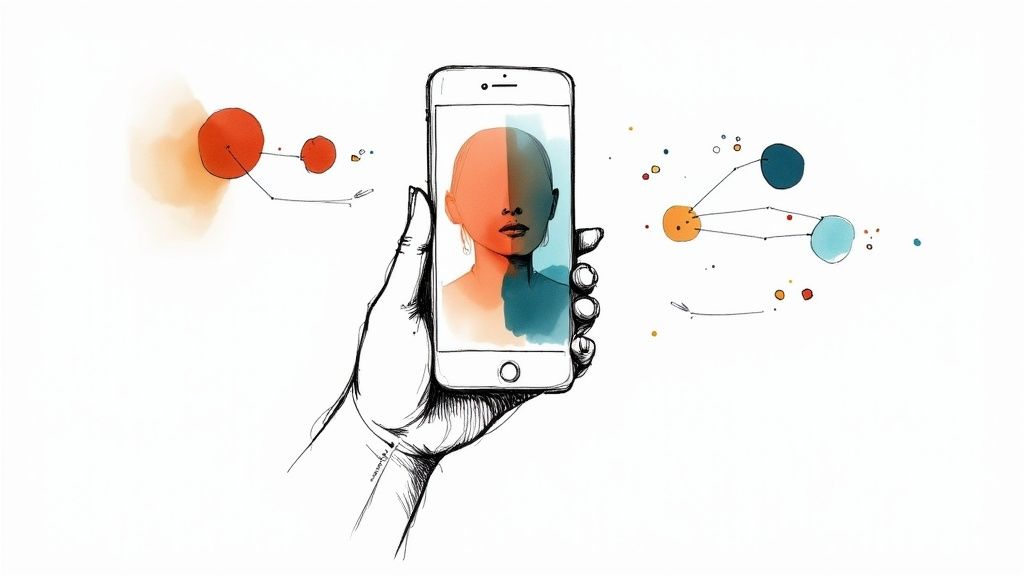
Your Guide to the Color Analysis Filter Trend
By Emma Johnson - 9/23/2025
If you’ve spent any time on TikTok or Instagram lately, you’ve probably seen them: color analysis filters. These are clever digital tools that use your phone’s camera and augmented reality to help you figure out which colors make you look your best.
It works by draping different seasonal color palettes—think Spring, Summer, Autumn, and Winter—over your face in real-time. The idea is to instantly see which shades light up your features and which ones fall flat.
Unpacking the Color Analysis Filter Trend
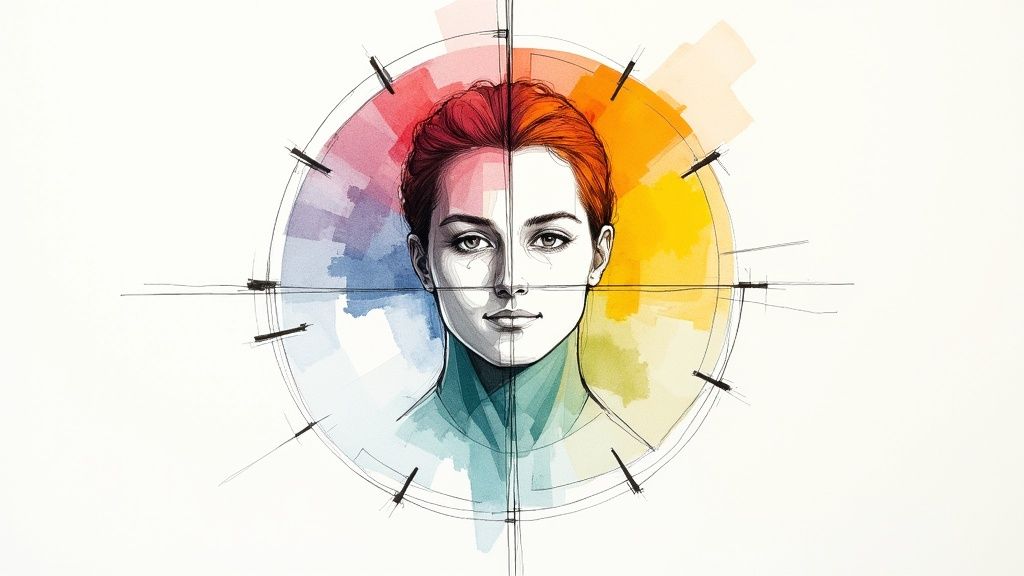
The snapshot above from a popular TikTok filter shows just how it works. By cycling through the seasons, you get a quick visual feel for how different hues interact with your unique skin tone, hair, and eye color. It's a surprisingly effective way to compare palettes side-by-side.
Think of it as having a personal stylist right in your pocket. The filter uses augmented reality (AR) to digitally simulate the traditional draping process that professional color consultants have used for decades, where they hold physical fabric swatches up to your face.
The goal is the same: to find your personal color season. You're looking for the set of colors that makes your skin look clear and vibrant, brings a sparkle to your eyes, and creates an overall sense of harmony.
The Technology Behind the Magic
This is more than just slapping a colored tint over your video. The filter's AI is actually analyzing your facial features—your skin, hair, and eyes—to get a read on your undertones (cool, warm, or neutral) and your overall contrast level.
The tech is similar to what you might find in beauty apps with selfie shade match tools, which use facial recognition to recommend the perfect foundation or lipstick shade.
This digital approach has some pretty clear advantages over the old-school way of doing things:
- It's Accessible: Got a smartphone? You can try it right now, for free, from your couch.
- It's Fast: You can test-drive all four seasonal palettes in less than a minute.
- It's a No-Pressure Experiment: This is a fun, low-stakes way to see yourself in colors you might never have thought to try on.
It's worth noting that the technology driving these fun social media filters is part of a massive industry. The global color filter market was valued at USD 4.23 billion and is expected to hit USD 5.3 billion by 2027, thanks to its use in everything from phone cameras to advanced medical equipment.
Digital Fun vs. Professional Precision
So, are these filters the final word on your color palette? Not exactly. While they're a fantastic starting point, it's crucial to know their limitations. Things like your phone's camera quality, your screen's color settings, and especially the lighting in your room can throw off the results in a big way.
An in-person consultation with a trained professional offers a much more controlled and accurate analysis. A stylist can see the subtle nuances in your skin tone under perfect lighting, using real fabric drapes to get it just right.
Let's break down the key differences.
Digital Filter vs In-Person Color Analysis
| Feature | Digital Color Analysis Filter | In-Person Professional Analysis |
|---|---|---|
| Accuracy | Varies based on lighting, camera quality, and screen calibration. | High, with controlled lighting and expert observation. |
| Cost | Typically free on social media apps. | A paid service, often a significant investment. |
| Convenience | Instant and can be done anywhere, anytime. | Requires scheduling an appointment and traveling to a consultant. |
| Method | Augmented reality simulates color drapes digitally. | Uses physical fabric drapes for a tangible comparison. |
| Personalization | Provides a general seasonal palette (e.g., "True Summer"). | Offers a highly customized palette with nuanced advice. |
| Expertise | Relies on an algorithm; no human feedback. | Direct access to a trained professional for questions and guidance. |
Ultimately, a color analysis filter is a brilliant introduction to the world of color theory. It gives you a solid foundation and gets you thinking about how colors work for you. Think of it as the fun first step on your journey to mastering your personal style.
The Smart Tech Behind Your Screen
Have you ever wondered how a color analysis filter instantly pegs you as a “Summer” or an “Autumn”? It’s not just a simple colored overlay slapped onto your screen. These tools are actually a clever mashup of a few different technologies working in concert, turning your phone into a surprisingly capable personal stylist.
The magic starts with Augmented Reality (AR). You can think of AR as a digital layer placed over the real world. First, the filter's software uses facial recognition to find key landmarks on your face—the line of your jaw, the position of your eyes, the shape of your lips. This process creates a live, moving 3D map of your features.
With that map in place, the AR can then "drape" digital swatches of color over your image with impressive accuracy. The colors don't just sit there, either. They follow your movements and shift with you, giving you a realistic preview of how light might reflect off fabric worn near your face.
The AI-Powered Color Detective
Here's where it gets really smart. Behind the AR visuals, an Artificial Intelligence (AI) algorithm is playing the role of a seasoned color consultant. It meticulously analyzes the pixels in your live video feed to figure out the fundamentals of your natural coloring.
- Undertone Analysis: The AI is trained to spot the subtle hints of yellow, gold, blue, or pink in your skin. This is how it determines if your undertone is warm, cool, or neutral.
- Contrast Assessment: It also measures the level of contrast between your hair, skin, and eyes. This helps slot you into a more specific seasonal sub-type, like "Deep Winter" or "Soft Autumn."
- Harmonization Feedback: As each palette is applied, the algorithm is constantly evaluating how well those shades harmonize with your features. It's looking for the colors that make your skin glow versus the ones that might make it look a bit washed out.
This intelligent analysis is essentially a digital version of what a trained consultant does with their own eyes. It’s like having an expert who has internalized decades of color theory, applying all of that knowledge to your face in an instant.
Miniaturization and Image Quality
None of this would work without the impressive hardware packed into your phone. The on-chip colour filters segment—a niche but booming part of the tech world—has grown right alongside consumer electronics. These incredibly tiny filters are built right onto your phone’s camera sensor, helping it separate colors efficiently and accurately.
This push toward miniaturization is what gives your phone the power to capture the nuanced color data the AI needs to do its job. If you're curious about the market for this technology, you can find more detailed insights from Markwideresearch.com.
When you bring it all together, the combination of AR mapping, AI analysis, and sophisticated camera hardware is what makes a color analysis filter more than just a novelty. It's a fantastic example of how complex technology can be used to solve a very personal, practical problem: finding the colors that make you look and feel your best.
Getting an Accurate Result from Any Filter
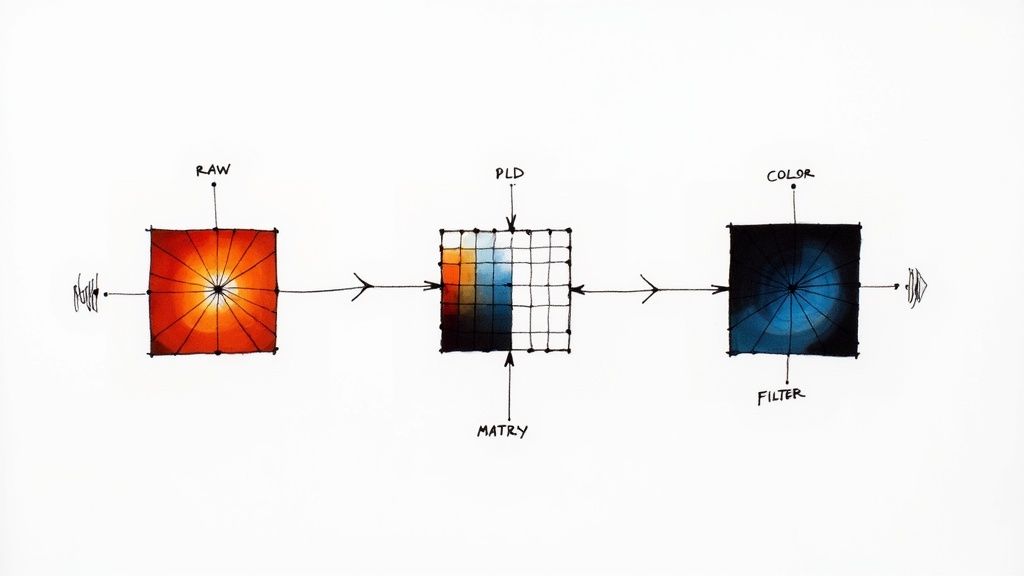
A color analysis filter is only as smart as the information you feed it. Think of your phone's camera as the filter's eyes—if the view is fuzzy, poorly lit, or has other colors interfering, the result you get will be a guess at best. To get a reading you can actually trust, you need to create the right conditions first.
This really boils down to giving the filter a clean, clear, and controlled view of your natural coloring.
Prepare Your Canvas
Before you even launch the app, a little prep work makes all the difference. The goal here is to strip away anything that could throw the algorithm off and make sure it’s seeing the real you.
Start with a Clean Face: This is non-negotiable. You need to remove every trace of makeup—foundation, concealer, blush, even mascara. That tinted moisturizer you love? It can absolutely skew the analysis by changing your surface tone. The importance of starting with clean skin for accurate results can't be stressed enough, as it lets the tech analyze your true undertones.
Pull Your Hair Back: If you color your hair, its current shade can clash with your natural tones and confuse the filter. Use a headband or hair tie to pull it completely off your face, paying special attention to your hairline.
Wear a Neutral Color: Steer clear of bright, dark, or patterned clothing. A simple white, grey, or off-white top is perfect. It won’t reflect any unwanted color onto your face and neck, which is a common mistake people make.
Find Your Perfect Lighting
Honestly, this is the single most crucial step. Bad lighting is the number one reason people get wonky, inconsistent results from these filters.
The gold standard for any color analysis, whether it's digital or with a pro, is indirect natural daylight. This soft, diffused light reveals your skin’s true undertones without casting harsh shadows or a warm or cool tint.
So, how do you find it? Stand facing a window during the day, but make sure you’re not in a direct, blinding sunbeam. And please, avoid artificial lighting at all costs. The yellow glow from your bedside lamp or the fluorescent lights in your office will completely distort your skin tone and guarantee a flawed result.
Analyze Your Results Like a Pro
Okay, you’re prepped and in position. Now it's time to test the palettes.
As you click through the different seasons, try not to get distracted by whether you like the colors. Instead, focus on what each palette does to your features. Watch for the subtle (and not-so-subtle) shifts happening on your own face.
Ask yourself these questions for each seasonal filter:
- Does my skin look healthy and vibrant? The right colors will make your skin look radiant, even, and clear. The wrong ones can make you look sallow, blotchy, or just plain tired.
- Do my eyes sparkle? A palette that’s in harmony with you will make your eyes pop, looking brighter and more defined. Unflattering colors can create the illusion of dark circles and make your eyes look dull.
- Is there a sense of balance? The best colors will feel like they belong with you, creating a beautiful, cohesive look. The wrong colors will either scream for attention and overpower you, or they'll make you fade into the background.
When you follow these steps, you’re not just playing with a fun filter anymore. You're using it as a serious diagnostic tool, and the result you get will be much closer to what a professional color analyst would see.
Understanding The Four Color Seasons
So, you’ve played around with a color analysis filter and it’s confidently labeled you an "Autumn." But what does that actually mean? This digital verdict comes from a long-standing theory that groups everyone's natural coloring into four categories: Spring, Summer, Autumn, and Winter. Each season corresponds to a specific palette of colors that naturally harmonizes with your features.
Think of it like this: nature already has its own perfect color schemes. The bright, warm yellows of spring flowers look just right against fresh green leaves. On the flip side, the cool, icy blues of a winter scene feel completely balanced. The very same idea applies to you. The right colors won't fight with your natural skin, hair, and eye tones—they’ll make them pop.
This whole concept boils down to three core elements of color theory:
- Undertone: This is the subtle tint beneath your skin's surface. Is it cool (blue, pinkish) or warm (yellow, golden)?
- Value: This simply refers to how light or dark your overall coloring is.
- Chroma: This measures how clear and bright or soft and muted your colors are.
Each of the four seasons has its own unique recipe mixing these three ingredients, which is what creates a distinct and flattering palette.
The Characteristics of Each Season
Let's get into the personality of each of the four main seasons. While a color analysis filter gives you a fantastic head start, really getting these fundamentals helps you make sense of your results and use them confidently. For a really detailed breakdown, you can dive much deeper into the world of seasonal color analysis.
Spring: This palette is all about warmth, light, and brightness. Think of a meadow on a sunny day. Springs have warm undertones, light value, and bright chroma. Their colors are fresh and lively—like warm peach, light mossy green, and vibrant coral.
Summer: This season is defined by coolness, light, and softness. The Summer palette is gentle, elegant, and serene, like a hazy afternoon in July. Picture dusty rose, soft lavender, and powder blue. Cool undertones, light value, and muted chroma are the key ingredients here.
Autumn and Winter Palettes
Autumn: Known for its signature warmth, depth, and muted tones. The Autumn palette is rich, earthy, and cozy, mirroring the colors of a fall harvest. Mustard yellow, terracotta, and deep olive green are classic Autumn shades. These individuals have warm undertones, a deep value, and muted chroma.
Winter: This palette is striking, crisp, and high-contrast. It’s identified by cool undertones, a deep value, and bright, clear chroma—think of a snowy landscape against a brilliant blue sky. It’s home to bold colors like true red, emerald green, and, of course, black and white.
The core idea is simple: wearing colors from your designated season creates visual harmony. Your best colors will make your skin look radiant and your eyes sparkle, while the wrong ones might leave you looking washed out or a bit tired.
Beyond these four primary groups, the system gets even more specific with twelve sub-seasons (like "Deep Winter" or "Soft Summer"). This extra layer of detail refines your palette even further by focusing on your most dominant trait—whether it’s your undertone, value, or chroma.
To give you a clearer picture, here's a quick cheat sheet summarizing the core traits of the four main seasons.
The Four Color Seasons at a Glance
| Season | Key Characteristics | Best Colors (Examples) | Celebrity Example |
|---|---|---|---|
| Spring | Warm Undertone, Light Value, Bright Chroma | Peach, Coral, Bright Green, Turquoise | Emma Stone |
| Summer | Cool Undertone, Light Value, Muted Chroma | Dusty Rose, Lavender, Powder Blue, Soft Gray | Emily Blunt |
| Autumn | Warm Undertone, Deep Value, Muted Chroma | Mustard, Terracotta, Olive Green, Rust | Julia Roberts |
| Winter | Cool Undertone, Deep Value, Bright Chroma | True Red, Emerald Green, Cobalt Blue, Black | Anne Hathaway |
This table helps you quickly see where you might fit and start experimenting with colors that are designed to make you shine.
The data shows that people are finding real, practical value in using filters to understand these principles.
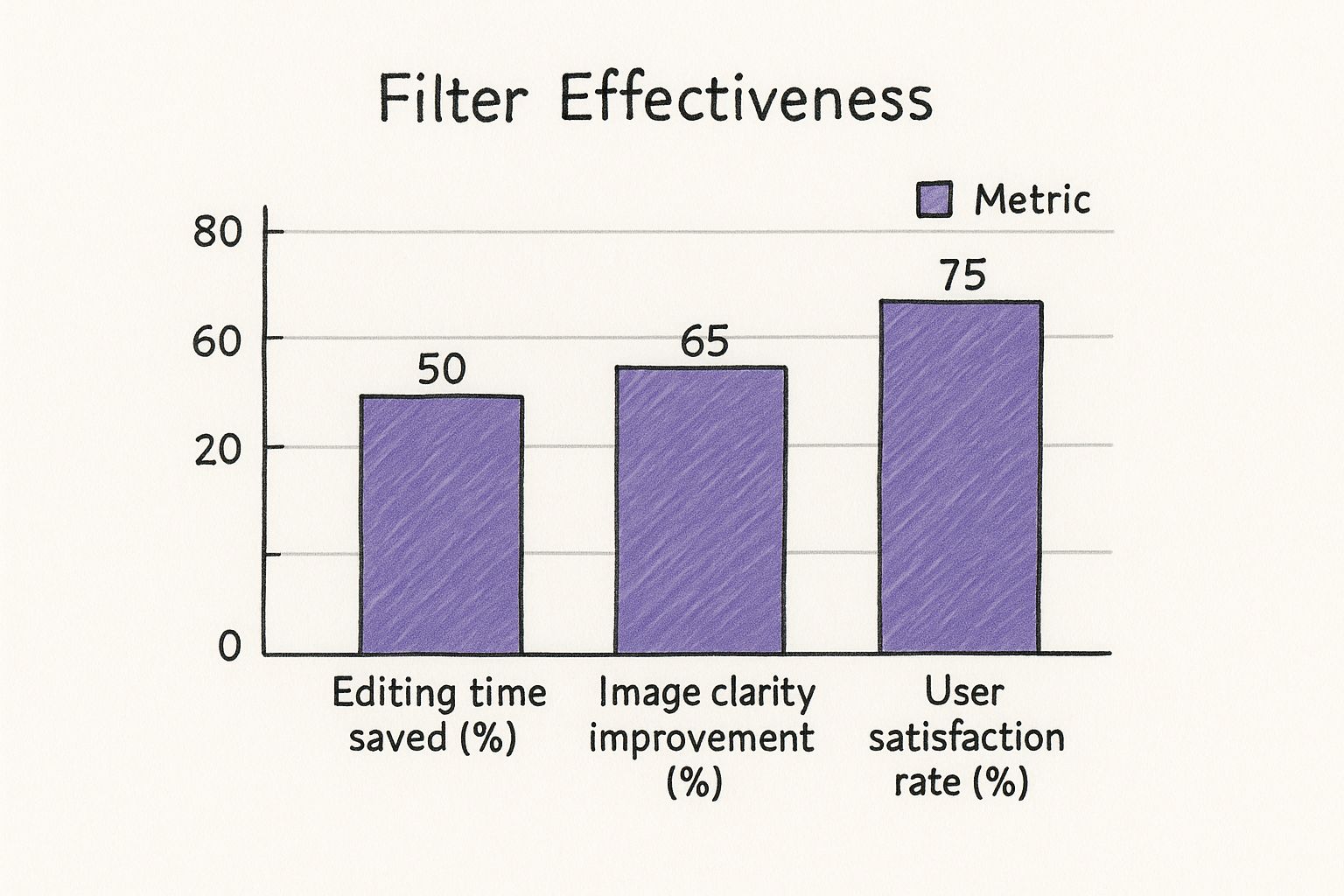
The high satisfaction rate proves this isn't just a trend; it’s a useful tool. This knowledge goes beyond just your clothes and makeup. You can apply it to accessories, too. For instance, a great guide on choosing the perfect eyeglass frame color for your skin tone can help you build a totally cohesive and flattering style from head to toe.
Translating Your Palette into Your Wardrobe
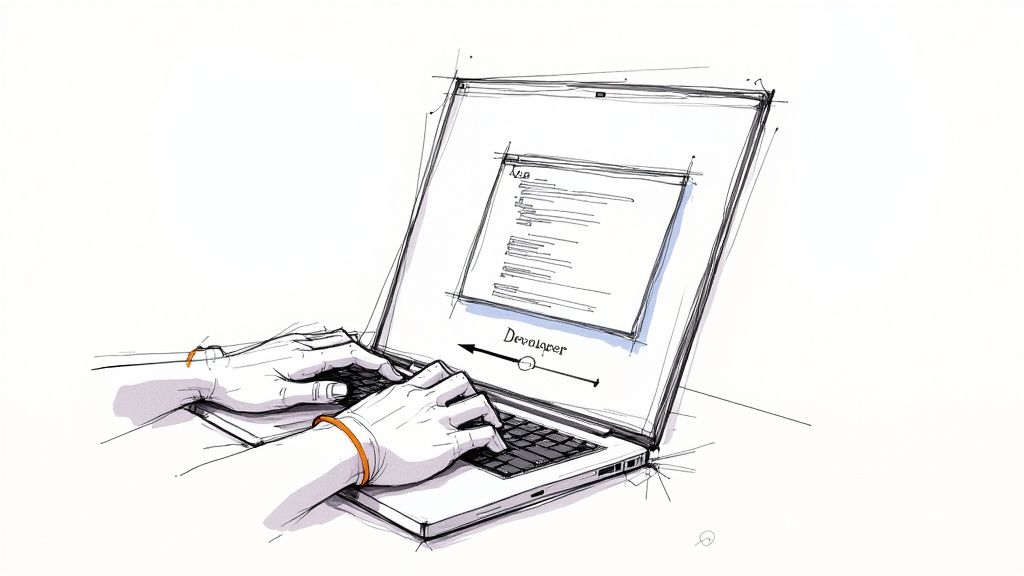
Alright, so you’ve discovered your color season. That’s the fun part! But now what? The next step is translating that digital discovery into your real-world closet and daily style.
Don't panic—this doesn't mean you need to toss everything and start from scratch. Think of it more as a gradual and mindful evolution. The whole point is to build a wardrobe that works for you, where every piece makes you look and feel fantastic.
Starting with Simple Swaps
The easiest way to begin is by making small, low-commitment changes. You don't need a huge budget or a dramatic makeover to see an immediate difference. The beauty of your palette is its harmony, and even a few key additions can elevate your entire look.
Here's how to dip your toes in:
- Accessories are your best friend. A scarf, a handbag, or some new earrings in one of your power colors is a perfect entry point. It's an affordable way to experiment and see the colors in action.
- Add a pop of color with makeup. Try a new lipstick or blush in a shade recommended for your season. The right hue near your face can instantly brighten your complexion and make your eyes sparkle.
- Focus on foundational pieces. The next time you need to replace a basic tee or a simple sweater, intentionally pick one from your new palette. Slowly but surely, you’ll build a core collection of items that all work seamlessly together.
The real magic happens when you realize everything starts to match. You can create more outfits with fewer items because every piece is designed to complement the others. It’s the ultimate solution to that classic "closet full of clothes, but nothing to wear" problem.
Building a Cohesive Wardrobe
Once you're comfortable with those smaller additions, you can start thinking about bigger pieces. Use your digital results from the color analysis filter as a trusted shopping guide. You might even find that your palette naturally includes colors you've always gravitated towards, making the whole process feel incredibly intuitive.
The technology that powers these filters is actually part of a much larger trend. Similar principles are used across many professional fields to create sharper, more vivid color on electronic displays, a market seeing huge growth according to DataIntelo.com. The same core idea applies to personal style: finding the colors that create the most clarity and vibrancy for you.
To really make this work long-term, it helps to understand the "why" behind your palette. Our guide on how to determine your color palette breaks down the principles of undertone and contrast. This knowledge empowers you to move beyond just the filter, helping you make smart, stylish choices on your own for years to come.
Got Questions About Color Analysis Filters? Let's Clear Things Up.
As you start playing around with color analysis filters, you're bound to have a few questions. It’s totally normal to wonder if they’re really accurate or what to do when one app calls you a Summer and another says you’re an Autumn. Let's tackle some of the most common questions so you can use these filters with a bit more confidence.
How Accurate Are These Filters, Really?
Honestly, for a free tool on your phone, a color analysis filter is a fantastic place to start. The tech is surprisingly good at picking up on your basic features and undertones right through your camera. But let's be real—they have their limitations.
Things like your phone's camera quality, your screen's color settings, and especially the lighting in your room can throw the results off. This is where a professional stylist has the edge; they use real fabric drapes in perfect lighting to see how different colors actually bounce onto your skin. It's a much more hands-on, nuanced process.
Think of a filter as a great first-pass screening. It can easily get you 80% of the way there. A pro consultation is more like the final diagnostic test that nails down those last, subtle details.
So, while a filter might not have the same precision as a trained expert, it gives you a solid starting point for figuring out your best colors.
What Should I Do If I Get Conflicting Results?
Getting different seasons from different apps is one of the most common frustrations. It almost always comes down to the fact that each app uses its own unique algorithm and its own interpretation of the seasonal palettes. Don't let it discourage you; there’s an easy way to sort through the confusion.
If you’re getting mixed signals, try this:
- Control Your Environment: Before anything else, make sure you test every filter in the same light. Find a spot with bright, indirect, natural daylight and stick to it.
- Look for the Pattern: Don't just rely on one filter. Try three or four popular ones. If three out of four suggest you're an "Autumn," that’s a pretty strong hint.
- Do a Side-by-Side Comparison: Take a screenshot with each filter. Then, pull them up next to each other. This simple trick lets you step back and see which color palette genuinely makes your skin look brighter and your eyes stand out.
If you're truly stuck between two seasons, just start exploring the colors for both. You’ll probably find you have a gut feeling and are naturally pulled toward one set of colors over the other. Trust that instinct!
Can My Color Season Change Over Time?
This is a fantastic question, and the answer isn't a simple yes or no. Your core skin undertone—that inherent warm, cool, or neutral quality—is locked in by your genetics. It doesn't change.
What does change is everything else: your hair color, the surface tone of your skin from tanning, and even your eye color can shift slightly.
For instance, as your hair starts to go gray, the level of contrast in your overall look might soften. A person who was a high-contrast "Deep Winter" in their youth might find the more muted "Cool Winter" colors feel more harmonious later in life.
It's less of a complete seasonal change and more of a subtle shift within your home season's family. That’s why it’s a good idea to revisit your palette every 5 to 10 years or after any big change, like deciding to stop coloring your hair. It just ensures your colors are always working for the person you are today.
Take your style to the next level with a professional analysis
You already know the theory. Now discover exactly which colors and styles enhance your personal image.
Loading...
Complete PDF report in less than 5 minutes
Your color season and personalized palette
Specific makeup and clothing recommendations
Based on professional color analysis
One-time investment:
One-time payment, no subscriptions. Instant access.